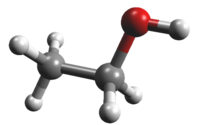|
Ethanol, aka ethyl alcohol, occurs in two distinguishable
conformers because of the orientation of the OH group.
The internal rotation of the CH3 group can be
neglected in most instances. The anti conformer is
lowest in energy, the doubly degenerate gauche
conformer is about 58 K higher in energy. Tunneling
between the two equivalent gauche conformers lifts
the degeneracy, causing a gauche+ and a
gauche– state which interact heavily.
The present entry is a modification of the JPL catalog entry
which is based on
(1) J. C. Pearson, C. S. Brauer, B. J. Drouin,
2008, J. Mol. Spectrosc. 251, 394.
The modifications were described by
(2) H. S. P. Müller, A. Belloche, L.-H. Xu, R. M. Lees,
R. T. Garrod, A. Walters, J. van Wijngaarden, F. Lewen,
S. Schlemmer, and K. M. Menten,
2016, Astron. Astrophys. 587, Art. No. A92.
Basically, it is a recalculation of the data provided
in the JPL catalog archive with a change in one of the
signs of the dipole moment components. The recalculation
together with the modified sign resolves intensity problems
pointed out already in (1) and that were also noticed in (2).
Extensive sets of transition frequencies were determined
in (1) along with very accurate energies of the
gauche substates. Additional data for the anti
conformer originate from
(3) J. C. Pearson, K. V. L. N. Sastry, M. Winnewisser,
E. Herbst, F. C. De Lucia,
1995, J. Phys. Chem. Ref. Data 24, 1;
and from references therein. Additional data for the
gauche conformer originate from
(4) J. C. Pearson, K. V. L. N. Sastry, E. Herbst, F. C. De Lucia,
1996, J. Mol. Spectrosc. 175, 246;
from
(5) J. C. Pearson, K. V. L. N. Sastry, E. Herbst, F. C. De Lucia,
1996, Astrophys. J. 480, 420;
and from references therein.
Predictions may be good as long as the predicted
uncertainties do not exceeed 200 or 300 kHz.
We refrained from merging experimental lines; we
recommend to inspect the
fit file for experimental lines, their
uncertainties, and their residuals.
Note: The partition
function takes into account the ground vibrational states
only. Approximate vibrational correction factors should be
available soon.
The dipole moment components of the anti conformer
were determined by
(1) M. Takano, Y. Sasada, and T. Satoh,
1968, J. Mol. Spectrosc. 26, 157
those of the gauche conformer by
(7) R. K. Kakar and C. R. Quade,
1980, J. Chem. Phys. 72, 4300.
Note: State number
2 signals the lowest energy anti conformer,
state numbers 0 and 1 the symmetric and antisymmetric
gauche conformer substates.
|
